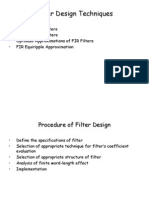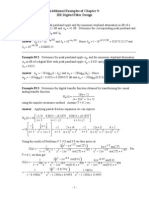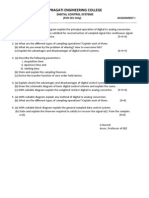Elliptic
Elliptic
Uploaded by
inertia116647Copyright:
Available Formats
Elliptic
Elliptic
Uploaded by
inertia116647Original Description:
Copyright
Available Formats
Share this document
Did you find this document useful?
Is this content inappropriate?
Copyright:
Available Formats
Elliptic
Elliptic
Uploaded by
inertia116647Copyright:
Available Formats
Elliptic Filters
The magnitude squared frequency response of the normalized low-pass elliptic filter of order n is defined by
Hn( j ) =
2
1 2 1 + Rn ( )
2
where Rn ( ) is a Chebyshev rational function of determined from the specified ripple characteristics
n odd
n even
Figure 1: Magnitude squared frequency response of elliptic LP filters of odd and even orders. Unlike the Butterworth and Chebyshev filters, =1 is calculated using
12 = 1
Report errors to mdwoodford@characterlink.net
A parameter, r representing the sharpness of the transition region is defined as
r =
2 1
Thus a large value of r indicates a large transition band, while a small value of r indicates a small transition band. The general transfer function H n (s ) , for the normalized low-pass elliptic filter is given from odd and even n by
2 H0 s 2 + A0i H n (s) = , odd n ( s + s 0 ) i =1 s 2 + B1i s + B0i n 2 n 1
s 2 + A0i H n (s) = H 0 2 , even n i =1 s + B1i s + B0 i
To design a filter n, H 0 , S 0 , A0i , B1i , B0i have to be determined from the design specifications (1) (2) (3)
or equivalently G1 ,G2 and r where
1 = 20 log H n ( j1 ) G1 = 20 log (1 + 2 ) 1 G2 = 20 log 2 = 20 log H n ( j 2 ) A
By finding the G1 and G2 in this fashion, the r requirement will not be satisfied exactly; however, an r can be selected that exceeds the requirements.
Report errors to mdwoodford@characterlink.net
Determination of n for Normalized Elliptic Filters The design of a low-pass normalized elliptic filter to satisfy the specifications G1 ,G2 and r using Table 3.6 is straight forward. (1) (2) (3) (4) Find G1 and G2 in dB. Find the r portion of the table for which a value less than the determined r is found. Find the corresponding order n. The values of 1 and 2 are obtained by
1 =
and
2 = r
Thus it can be clearly verified that the requirements have been met. The design of an un-normalized elliptic low-pass filter satisfying a G1 dB ripple, cutoff at ' 1' and a G2 dB gain at 2 can be obtained by LP ->LP transformation of a mutable normalized elliptic filter
H ( s ) = H LP ( s ) |
s s
' For the elliptic filter 0 is selected to be the geometric mean of 1' and 2
' 0 = 1' 2
The corresponding LP requirements, 1 , 2 and r (transition) are obtained as follows
1' 1 = 0 2 = r =
' 2 0 ' 2 2 = ' 1 1
Report errors to mdwoodford@characterlink.net
Example #1 Find the transfer function for an elliptic low-pass filter with 2 dB cutoff value at 10,000 rad/s and a stop band attenuation of 40 dB for all past 14,400 rad/s. Solution
1' = 10,000rad / s
' 2 = 14,400rad / s
G1 = 2dB G2 = 40dB
Then
' 0 = 21' = (1 *10 4 )(1.44 *10 4 ) = 12,000
1' 10,000 5 = = 1 = 0 12,000 6 2 =
' 2 14,400 6 = = 0 12,000 5
r = 2 = 5 = 1.44 1 5
6
From the 2 dB and 40 dB part of the table it is seen that for n = 4 given r = 1.40542. Thus H LP ( s ) = 0.01( s 2 + 7.25202)( s 2 + 1.57676) ( s 2 + 0.467290s + 0.212344)( s 2 + 0.127954s + 0.677934)
The required LP is obtained by
H ( s ) = H LP ( s ) |
s s 12 , 000
Report errors to mdwoodford@characterlink.net
Example #2 Find the transfer function H(s) for a normalized elliptic filter that will satisfy the following conditions: G1 = 0.5dB G2 = 30dB
r = 1.21
From table 3.6a with pass-band ripple of 0.5 dB and stop-band gain of 30 dB, the smallest value of n that satisfies the r is n = 5, giving r = 1.12912. H 5 ( s) = Where 0.118807( s 2 + 2.14490)( s 2 + 1.18122) ( s + 0.511701)( s 2 + 0.480774s + 0.648724)( s 2 + 0.088080s + 0.907216)
1 =
= 0.941087
2 = r = 1.12912 = 1.06260
Report errors to mdwoodford@characterlink.net
You might also like
- Chapter 4B Part B: Digital Processing of Continuous-Time Signals Design of Analog FiltersNo ratings yetChapter 4B Part B: Digital Processing of Continuous-Time Signals Design of Analog Filters3 pages
- Butterworth Filter Design: Ω N is the order of the filterNo ratings yetButterworth Filter Design: Ω N is the order of the filter3 pages
- Low-Pass Filter:: S S S in The Numerator, First Order Filters Are Classified As Lowpass, HighpassNo ratings yetLow-Pass Filter:: S S S in The Numerator, First Order Filters Are Classified As Lowpass, Highpass6 pages
- Challenge 25 Exam #4 Review Topical Coverage: FIR/IIRNo ratings yetChallenge 25 Exam #4 Review Topical Coverage: FIR/IIR29 pages
- Computer Physics Communications 1 (1969 10-14. North-Holland Publishing Comp., AmsterdamNo ratings yetComputer Physics Communications 1 (1969 10-14. North-Holland Publishing Comp., Amsterdam5 pages
- N N C A: Compiled by AH Tan, November 2012No ratings yetN N C A: Compiled by AH Tan, November 20126 pages
- Low-Sensitivity Active-Rc High-And Band-Pass Second - Order Sallen & Key Allpole FiltersNo ratings yetLow-Sensitivity Active-Rc High-And Band-Pass Second - Order Sallen & Key Allpole Filters4 pages
- Microwave Discrete and Microstrip Filter Design: BackgroundNo ratings yetMicrowave Discrete and Microstrip Filter Design: Background25 pages
- EEE C364/INSTR C 364 Analog ElectronicsNo ratings yetEEE C364/INSTR C 364 Analog Electronics12 pages
- Cell: 9952749533 WWW - Researchprojects.infoNo ratings yetCell: 9952749533 WWW - Researchprojects.info55 pages
- Prototype Analog Low Pass Filters: Cut-ONo ratings yetPrototype Analog Low Pass Filters: Cut-O3 pages
- Laser Fundamentals: Basic Processes (A.Einstein, 1916)No ratings yetLaser Fundamentals: Basic Processes (A.Einstein, 1916)11 pages
- Fundamentals of Electronics 3: Discrete-time Signals and Systems, and Quantized Level SystemsFrom EverandFundamentals of Electronics 3: Discrete-time Signals and Systems, and Quantized Level SystemsNo ratings yet
- Feynman Lectures Simplified 2C: Electromagnetism: in Relativity & in Dense MatterFrom EverandFeynman Lectures Simplified 2C: Electromagnetism: in Relativity & in Dense MatterNo ratings yet
- Module 1-Introduction and Image Parameter MethodNo ratings yetModule 1-Introduction and Image Parameter Method83 pages
- Essentials of Fire Fighting: 6 Edition Chapter 3 - Fire Department CommunicationsNo ratings yetEssentials of Fire Fighting: 6 Edition Chapter 3 - Fire Department Communications6 pages
- Milan Jelinek, Redwan Salami, Sassan Ahmadi, Bruno Bessette, Philippe GournayNo ratings yetMilan Jelinek, Redwan Salami, Sassan Ahmadi, Bruno Bessette, Philippe Gournay4 pages
- Radar Systems Engineering - MATLAB & SimulinkNo ratings yetRadar Systems Engineering - MATLAB & Simulink2 pages
- Image Compression & Redundancies in A Digital Image:: Interpixel Redundancy, andNo ratings yetImage Compression & Redundancies in A Digital Image:: Interpixel Redundancy, and7 pages
- Spectrum Physics Lab: N.K.Mandal/916302 8788100% (1)Spectrum Physics Lab: N.K.Mandal/916302 878812 pages
- Chapter 2 Data Services in GSM System: What GPRS IsNo ratings yetChapter 2 Data Services in GSM System: What GPRS Is19 pages
- Flexi Zone Small Cell, Micro RRH and AirScale Indoor100% (4)Flexi Zone Small Cell, Micro RRH and AirScale Indoor39 pages
- 2G Data (Paper Reacharge) : New New New New New0% (1)2G Data (Paper Reacharge) : New New New New New9 pages
- The Activity Aims:: Familiarization of The Oscilloscope100% (1)The Activity Aims:: Familiarization of The Oscilloscope40 pages
- Chapter 4B Part B: Digital Processing of Continuous-Time Signals Design of Analog FiltersChapter 4B Part B: Digital Processing of Continuous-Time Signals Design of Analog Filters
- Butterworth Filter Design: Ω N is the order of the filterButterworth Filter Design: Ω N is the order of the filter
- Low-Pass Filter:: S S S in The Numerator, First Order Filters Are Classified As Lowpass, HighpassLow-Pass Filter:: S S S in The Numerator, First Order Filters Are Classified As Lowpass, Highpass
- Challenge 25 Exam #4 Review Topical Coverage: FIR/IIRChallenge 25 Exam #4 Review Topical Coverage: FIR/IIR
- Computer Physics Communications 1 (1969 10-14. North-Holland Publishing Comp., AmsterdamComputer Physics Communications 1 (1969 10-14. North-Holland Publishing Comp., Amsterdam
- Low-Sensitivity Active-Rc High-And Band-Pass Second - Order Sallen & Key Allpole FiltersLow-Sensitivity Active-Rc High-And Band-Pass Second - Order Sallen & Key Allpole Filters
- Microwave Discrete and Microstrip Filter Design: BackgroundMicrowave Discrete and Microstrip Filter Design: Background
- Laser Fundamentals: Basic Processes (A.Einstein, 1916)Laser Fundamentals: Basic Processes (A.Einstein, 1916)
- Fundamentals of Electronics 3: Discrete-time Signals and Systems, and Quantized Level SystemsFrom EverandFundamentals of Electronics 3: Discrete-time Signals and Systems, and Quantized Level Systems
- Analog Dialogue, Volume 48, Number 1: Analog Dialogue, #13From EverandAnalog Dialogue, Volume 48, Number 1: Analog Dialogue, #13
- Exercises in Electronics: Operational Amplifier CircuitsFrom EverandExercises in Electronics: Operational Amplifier Circuits
- Shortcuts to College Calculus Refreshment KitFrom EverandShortcuts to College Calculus Refreshment Kit
- Feynman Lectures Simplified 2C: Electromagnetism: in Relativity & in Dense MatterFrom EverandFeynman Lectures Simplified 2C: Electromagnetism: in Relativity & in Dense Matter
- Essentials of Fire Fighting: 6 Edition Chapter 3 - Fire Department CommunicationsEssentials of Fire Fighting: 6 Edition Chapter 3 - Fire Department Communications
- Milan Jelinek, Redwan Salami, Sassan Ahmadi, Bruno Bessette, Philippe GournayMilan Jelinek, Redwan Salami, Sassan Ahmadi, Bruno Bessette, Philippe Gournay
- Image Compression & Redundancies in A Digital Image:: Interpixel Redundancy, andImage Compression & Redundancies in A Digital Image:: Interpixel Redundancy, and
- Chapter 2 Data Services in GSM System: What GPRS IsChapter 2 Data Services in GSM System: What GPRS Is
- Flexi Zone Small Cell, Micro RRH and AirScale IndoorFlexi Zone Small Cell, Micro RRH and AirScale Indoor
- The Activity Aims:: Familiarization of The OscilloscopeThe Activity Aims:: Familiarization of The Oscilloscope

























































































